We spent a month traveling across southern Europe from Croatia through Italy and across the Mediterranean Sea to Spain. Thursday October 6th, we flew from New York City to Bologna, Italy. We arrived in Bologna Friday night October 7th and checked into our hotel. It was just steps away from the 15th century Piazza Maggiore.

Bologna is a charming medieval university town where, according to a local taxi driver, “All the Italians come to eat.” Many of the medieval buildings have been restored and are well maintained. The city is home to the University of Bologna established in 1088 AD. It is the oldest university in the western world.

The Clock Tower was built about 1250 on top of the Palazzo d’Accursio. The clock was installed inside the tower in 1444. Today, Palazzo d’Accursio houses the public library and the town hall of Bologna. The tower is open to visitors to climb to the top for wonderful views of the city and to see the clockworks. We stayed at the lovely Art Hotel Orologio which is located near the famous clock tower.

Bologna is known as the “porticoed city” because there are 25 miles of covered walkways throughout the city. Porticos were common in the Middle Ages because they provided more living space above the first floor. Bologna’s porticos are listed as a UNESCO World Heritage Site.

It was fun to walk around the city along narrow medieval streets. Many of the alleyways were lined with shops and outdoor restaurants on the ground-floor level.


People were out strolling or riding bicycles at all hours of the day and night. The commercial center of the old town, named the “Quadrilatero,” is comprised of several narrow streets near the Piazza Maggiore, filled with small shops selling meat, fish, cheese, bread, and pastries.
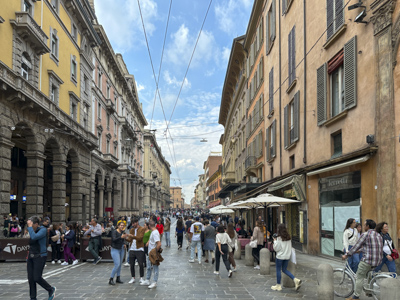
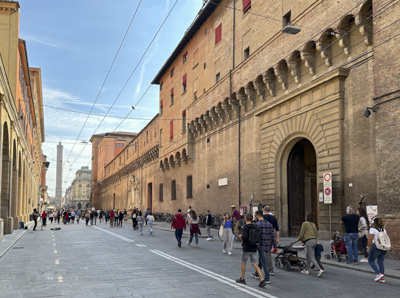
Paolo Atti & Figli was founded in 1880 and is famous for their traditional fresh hand-made pasta. Tagliatelle, tortellini, and lasagna are said to have been invented in Bologna. The city is nicknamed: “la dotta, la grassa, la rossa” – the learned, the fat, and the red – referring to its university, its cuisine, and the red-colored roofs and bricks of the buildings.
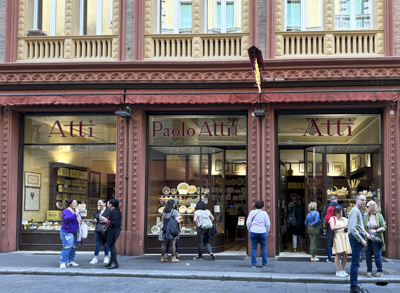
Bologna is located in northern Italy in the Emilia-Romagna region, between Venice and Florence. For more information about Bologna, I recommend the website: www.bolognauncovered.com


We spent three nights and two full days in Bologna before taking a taxi to the nearby city of Ravenna to board the Azamara Pursuit to cruise the Adriatic Sea and visit towns along the Dalmatian Coast of Croatia.

Monday October 10: The morning was cloudy and cool when we boarded the Azamara Pursuit. With less than 600 passengers, the ship was the smallest cruise ship we had ever sailed on. We arrived early and had time to explore our new accommodations for a “7-Night Croatia Intensive Voyage.”


Azamara had recently severed ties with its parent company, Royal Caribbean. The new independent company was attempting to be a part of the luxury cruise business by offering free gratuities, a free basic drinks package, on-board credits, as well as free laundry!

“Intensive Voyage” means a new port every day! The ship sailed at night and early the next morning we arrived at a new city. At dawn on October 11, the Pursuit anchored off the Croatian town of Opatija.

The lovely seaside town of Opatija located on the Kvarner Gulf has a population of apx. 5,700 people. It is a popular summer and winter resort with several grand hotels dating from the late 1800s. The most popular activity in Opatija is to walk along the 7.5 mile seaside walkway known locally as the Lungomare.

The tender put us ashore near the promenade and since it was a beautiful sunny day, we walked along the gorgeous coast. The Lungomare was finished in 1911 after Opatija was declared a “climatic health resort.”
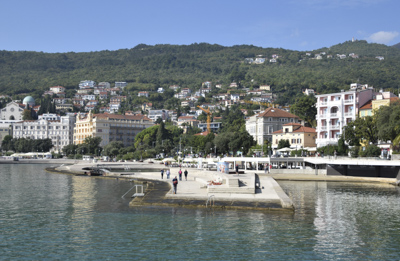

We passed through Angiolina Park which has been known for its rare plant species since the late 1800s. The exterior wall of the Open Air Theater is decorated with portraits of famous people who were either born in Opatija or who visited the coastal town.

My favorite site along the Lungomare was the Maiden With the Seagull, which is a statue of a young girl with her arm outstretched to a fluttering seagull. The statue was made by the Croatian sculptor Zvonko Car in 1956. For more information about this charming coastal town see: www.visitopatija.com

Wednesday October 12: Zadar, Croatia: Life aboard any ship becomes routine rather quickly. The crew aboard the Azamara Pursuit was friendly and helpful; the small size of the ship made it very manageable. The ship docked early in the next morning at the edge of the old town of Zadar, Croatia. After a leisurely breakfast outdoors on the aft-deck, we were ready to explore a new city.
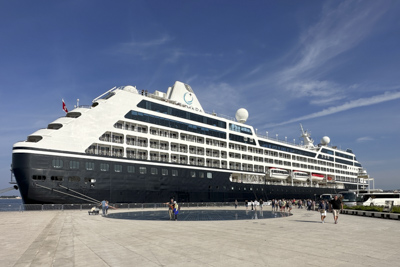
On the dock next to the ship were two multi-sensory art installations created by the Croatian architect Nikola Basic. The Sea Organ was made of concrete steps leading down to the water. The waves interact with a cavity built under the steps creating random but harmonic sounds. The sounds are emitted from holes made in the concrete. People sit on the steps to relax and listen to the soothing groans of the sea.

The other artwork built into the promenade was called the Greeting to the Sun. Also designed by Nikola Basic, it was a large circular work embedded in the concrete. During the day panels absorb energy from the sun and light up at night with random patterns and colors. Both artworks were impressive and amazing!

After spending some time enjoying Nikola Basic’s creations, we walked along the promenade to the ruins of a Roman Forum. Beyond the ancient columns was the 9th century Church of St. Donatus.

Modern high-end shops line both sides of Siroka Ulica (‘ulica’ means street in Croatian) and we were immediately thrust into the 21st century. The street ends at Narodni Trg or People’s Square which was filled with many tourists eating and drinking under restaurant umbrellas. A clock tower was built in the early 19th century and mounted on top of a 16th century Venetian era building. Today it is a museum.


We returned to the ship via small back streets which were lined with tourist shops selling everything from gelato to t-shirts. The stone pavement was very clean and shiny and looked like it had been polished. Later after dark, we went ashore to experience the lights of the Greeting to the Sun.

Local people and tourists lined the promenade to see, hear, and experience the two wonderful artistic creations. We sat on the steps to listen to The Sea Organ which emitted a variety of sounds due to increased waves. The sounds were like a soft low-pitched fog horn.

Thursday October 13: The Pursuit arrived at the dock in Split, Croatia early in the morning. Split is a big city spread along the Adriatic coast. White limestone mountains were visible beyond the city buildings. Split was founded by the Greeks in the 3rd century BC and it has a long history of invasions and conquests.

The site was chosen by the Roman Emperor, Diocletian, as his retirement home in 305 AD. He ordered the construction of an opulent fortified palace to be built on the coast. The palace was designed like a huge Roman military fortress. Interestingly, over many centuries, the townspeople inhabited the palace and the city of Split grew and developed in and around it. Today the palace is part of the city.

We entered the old palace through one of four gates called the Brass Gate and found ourselves under thick ancient arches. We climbed up high stone steps to the Peristyle (courtyard). This was the central square where Emperor Diocletian made appearances to greet his subjects.
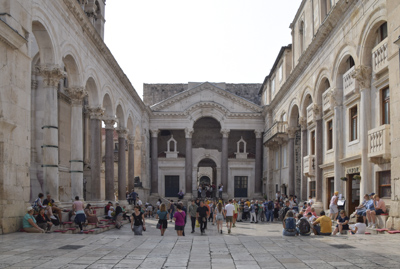
The Cathedral of Saint Domnius was built and consecrated in the 7th century and houses Diocletian’s tomb. The Bell Tower of the Cathedral was built in the 12th century and looms over the Peristyle Square.
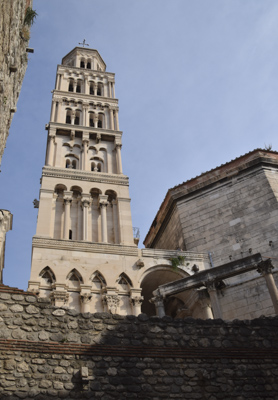
It was fun to wander the ancient narrow streets of the palace. Today, about 3,000 people live within the old palace walls and it is listed as a UNESCO World Heritage Site.

After wandering for a while, we discovered the Golden Gate of the palace wall and passed through it to see the great statue of the Protector of Split: Gregory of Nin or Grgur Ninski.

Bishop Gregory of Nin was a medieval bishop who encouraged the use of the Croatian language in Catholic religious services instead of Latin in 926 AD. The 28 foot tall statue was erected in 1929. People are supposed to rub the statue’s toe to obtain good luck.

The palace was a hodgepodge of architecture which reflected many centuries of invading cultures and waves of dominant groups along the Dalmatian Coast. We walked through the Iron Gate to the People’s Square which was another attractive area for people to gather at the restaurants.

We returned to the ship and prepared for an Azamara White Nights Party held on deck around the pool.

The party was a lot of fun with good company and tasty food outdoors. Everyone was supposed to wear white and we did the best we could, but no-one really cared. It was a fun enjoyable social evening.

Friday October 14: Early the next morning, the ship anchored in a tiny harbor near the old town of Dubrovnik, Croatia. The city is known for its distinctive massive stone walls which were erected in the 16th century. Dubrovnik has become a very popular and crowded tourist destination in recent years.
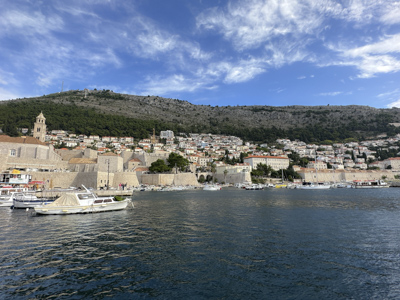
We rode a tender to the small protected dock just outside the sea-gate entrance into the city.
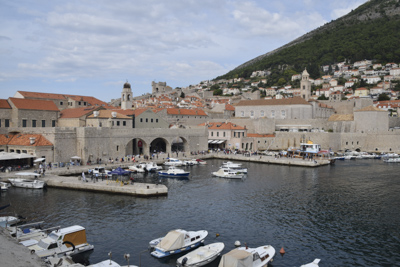
Dubrovnik, historically known as Ragusa, was founded in the 7th century by the Greeks.

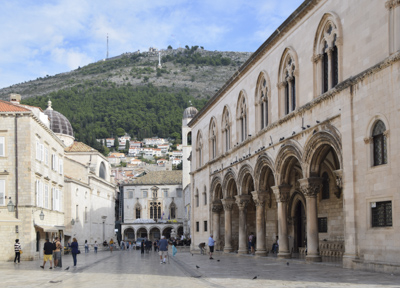

We walked along the Stradun to one of the stairways to the top of the wall. Dubrovnik has become such a popular tourist destination that the city charges 25 euros per/person to walk on the wall.

I could have taken a million pictures from the top of the wall. There seemed to be beautiful scenery and spectacular views everywhere and at every turn.

I love walking on ancient city walls and we have experienced quite a few from Lucca, Italy to Xian, China. It gives me an appreciation for how insecure and afraid the residents must have felt before they built a wall in an attempt to keep out invaders.


Back on the ship that evening, we heard a performance given by a Croatian cellist, Ana Rucner. She played several jazzed-up short pieces which we recognized as composed by Orff, Vivaldi, and Beethoven and she also played and sang several Croatian folk songs. Her cello looked like a white metal outline of a traditional cello and sounded more like an electric bass guitar played with a bow. Thankfully, it was a short performance.
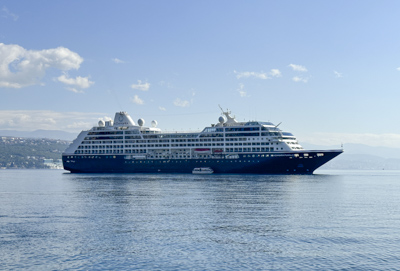
Saturday October 15: The Pursuit cruised to the island of Hvar, Croatia and dropped anchor just off the town of Hvar. The island was listed as one of the ten most beautiful islands in the world by a travel magazine. It is known as ‘the island of sunshine, beaches, wine, olive oil, and lavender.’
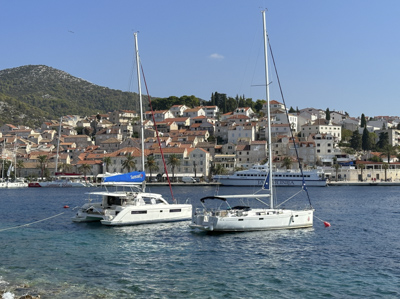
High on a hill above town is the Fortica Fortress. The Venetians began construction of the fortress in 1278 but the current structure was completed in 1551. Today it is a tourist destination for its spectacular views and it supposedly houses a collection of amphoras. We did not climb up to visit the fort.

The weather was perfect: crystal clear cloudless blue sky and a warm sun with 70 degree temperatures. Hvar was another summer resort with inviting hotels and a seaside promenade and gorgeous scenery.
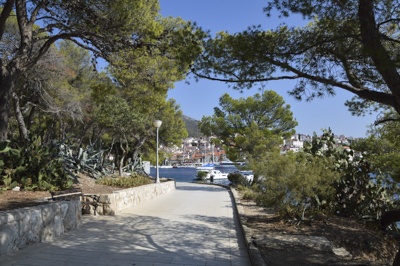
We passed many large cactuses and hardy succulents among the umbrella pines and palm trees as we strolled along the coast. I could understand why the island is so popular.

Sunday October 16: The captain had recommended that we watch the ship navigate through the very narrow St. Anthony Channel at sunrise and I happened to be up and took pictures from our veranda. I felt like I could reach out and touch the rocks and I was impressed by the captain’s ability to maneuver the ship through the narrow channel. The strait connects the Adriatic Sea to Sibenik Bay and to our next port of call which was the city of Sibenik.

We had elected to go on an excursion to another historic city, so we didn’t really see much of Sibenik. We were told that there is an old town center with an old church, but we had other plans.

A charter bus drove us to the historic town of Trogir, Croatia which is located on a small island and is listed as a UNESCO World Heritage Site for its Venetian architecture. It was founded by the Greeks in the 3rd century BC and was ruled by the Venetians for almost four centuries.
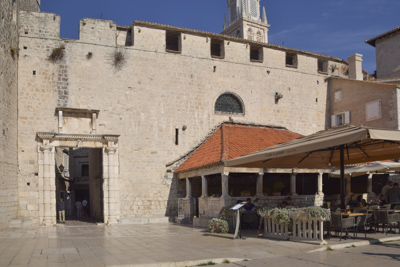
The historic town and harbor of Trogir is said to be the best-preserved Romanesque-Gothic complex in all of Central Europe. According to UNESCO, “Its beautiful Romanesque churches are complemented by the outstanding Renaissance and Baroque buildings from the Venetian period.”

Trogir was a small compact medieval town with narrow alleyways opening to small plazas. A wide promenade along the shore was lined with large palm trees and tourist restaurants.

At the end of the island was Kamerlengo Castle. The fortress was built in the 15th century and today is used for outdoor performances during the summer.

This was the last day of our “Azamara Intensive 7-Day Croatia Cruise” – and it certainly was ‘intensive.’ We both longed for a ‘sea day’ sometime during the week to take a break and process all the sights. In the afternoon, we joined our Trivia Group for a final successful win. By now, we were a group of nine, so it really was an easy win – and a lot of fun! Later, we enjoyed dinner and conversation with four of our new friends. We shared two bottles of a California favorite and recommended wine. A real treat!

Monday October 17: The Pursuit docked at Ravenna, Italy in a very thick fog. Our driver picked us up and drove us back to Bologna. The plan was to stay one night in Bologna and take the high-speed train to Rome tomorrow. It was actually fun to return to Bologna, which was now a city we knew and enjoyed.

We arrived at Piazza Maggiore early enough to have cappuccinos at an outdoor cafe overlooking the Fuente de Neptuno. The bronze statue of Neptune was installed in 1566 and is a famous city landmark.

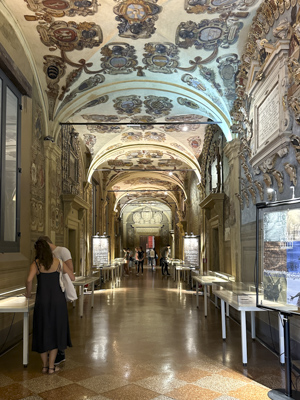
One of the most interesting sights in Bologna is the Biblioteca Comunale dell’ Archiginnasio which became the university’s main academic building when it was constructed in 1563. Today it houses a public library – with 850,000 volumes – and the old Anatomical Theatre.
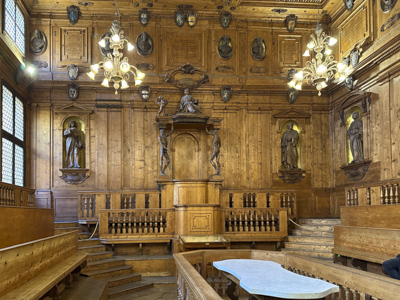
The Anatomical Theatre was constructed in 1636 for medical lectures and displays. The building suffered extensive damage in 1944 and the theatre was reconstructed using original materials.

Tuesday October 18: Rome, Italy: We caught an afternoon high-speed train from Bologna to Rome. Under a bright blue sky, we zipped through the beautiful farmlands of Italy at speeds up to 288kms per hour. Rome was a beehive of tourist activity and, surprisingly, the temperature was 80 degrees. We checked in to our hotel near the Campo de’ Fiori and explored the neighborhood.

We had been to Rome twice before so we knew our way around the glorious city and we had planned what we wanted to do during these two days. To me, it’s fun to return to a place and experience it again and see how it has changed, like visiting an old friend. Rome was definitely an “old friend.”
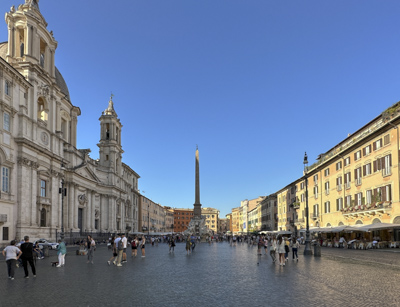
Wednesday October 19: We set our alarms for 5:45am because we had pre-arranged tickets for early morning access to the Vatican Museum before it opened to the public. The tickets were called “Breakfast at the Vatican” and we had to be at the entrance at 7:15 for our small group tour.
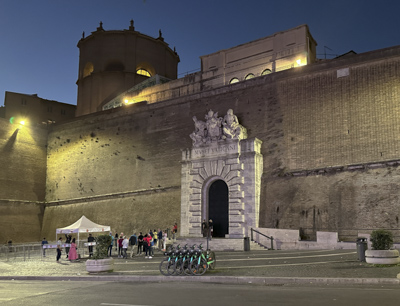
The tour was well worth getting up at such an early hour. The group was comprised of about fifteen adults and we were the first people to enter the museum that day. It was glorious to be able to look at the art and treasures of the collection without the distractions of throngs of people.
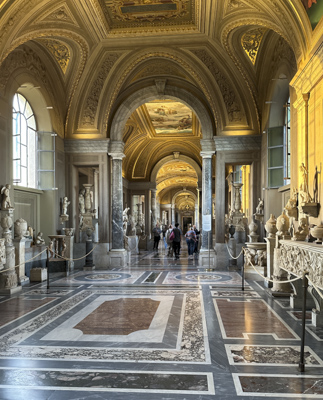
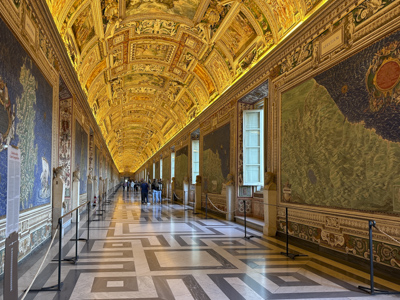
Fortunately for us our tour leader was excellent and, as she slowly progressed through the galleries, she explained the highlights of the most important elements in the galleries.

Although no photography was allowed in the Sistine Chapel, we were able to sit down under the famous ceiling for a long period of time and listen to the tour guide explain the history and stories of the panels and describe Michelangelo’s process of creating the beautiful frescos. She also described the other frescos around the walls of the Chapel, which are often overlooked but were created by Botticelli, Ghirlandaio, and other well known artists of the time. This was an amazing and unforgettable experience.

Our tour finished about 9:30 and we enjoyed an “American Breakfast” in a covered outdoor area set aside for tour ticket-holders. Afterwards, we had to plow our way through the crowds entering the museum. Pre-arranged timed tickets are necessary to gain admittance to all the museums nowadays.
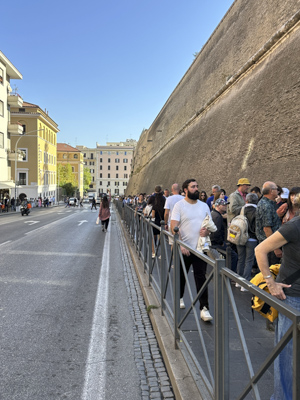
We thought it would be interesting to revisit St. Peter’s Basilica. We walked around the Vatican wall to the main square to discover that access to pedestrians was blocked by police and other security forces. On one side there was a very long line of people waiting to get into St. Peter’s. So, we changed our minds! A taxi driver told us that the pope has his audiences on Wednesdays so there is more security.
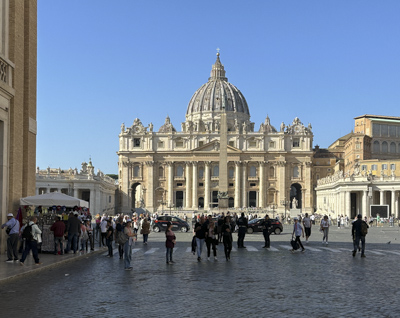
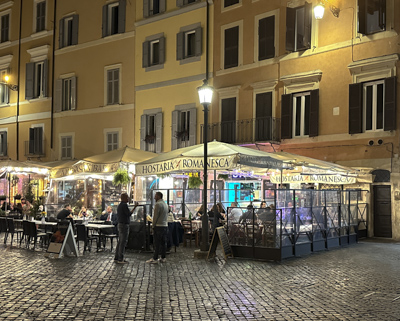
Thursday October 20: We had only two full days in Rome on this trip so we planned to visit one special place each day. Today we had timed-tickets to the Galleria Borghese. This is a wonderful art gallery housed in the Villa Borghese surrounded by a beautiful city park high on a hill in Rome.
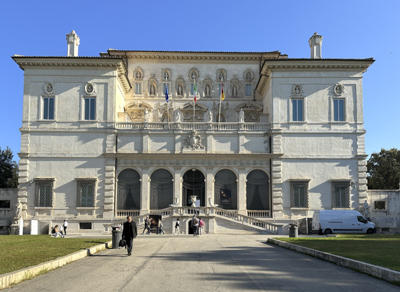
The villa was built by Cardinal Scipione Borghese in 1633 to house his collection of antiquities, sculptures, and paintings. The building is a work of art and it is the best place to see some of Bernini’s magnificent statues. The Galleria also owns a large number of Caravaggio paintings.
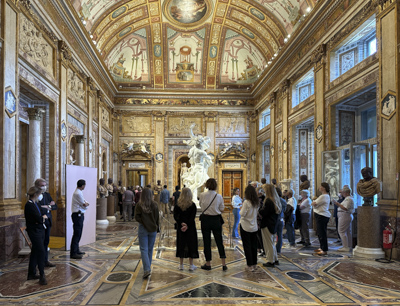
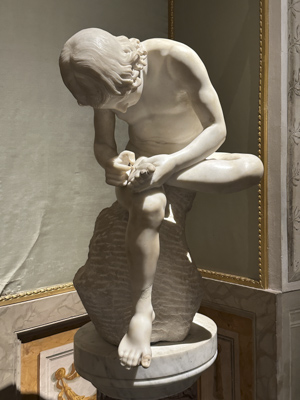
We walked from the Borghese Gardens to the Campo de’ Fiori passing several of Rome’s most famous sights: Piazza Spagna, Fontana di Trevi, Pantheon, and Piazza Navone. Everywhere we went was crowded with too many tourists. I guess we weren’t the only people in the world who wanted to travel!

Friday October 21: Our time in Rome was ending so we checked out of our cozy hotel and hired a car to take us to the Port of Civitavecchia. We boarded the Azamara Onward and began a “7-Day Intensive Mediterranean Cruise” from Rome to Barcelona with island stops along the way.
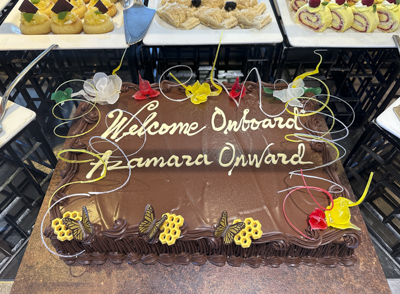
Saturday October 22: We had settled into our cabin and explored. The Onward was identical to the Azamara Pursuit so we felt right at home. The ship arrived at the city of Portoferraio, Elba as the sun was rising. The city was built on steep hills on a narrow peninsula surrounded by the sea.
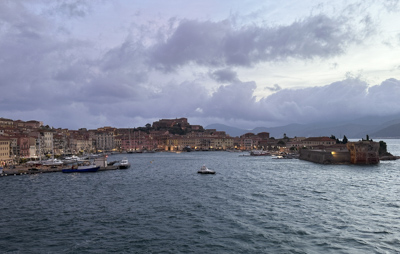
Elba is a small island which is part of the region of Tuscany and is located six miles off the Italian coast. The population is about 30,000 residents and it is primarily a summer resort destination. The island became internationally well known when Napoleon Bonaparte was exiled to Elba from 1814 to 1815.

We signed up for an excursion because we wanted to visit the Villa de San Martino which had been Napoleon’s summer residence. It was a small unassuming stone building decorated with characteristic capital “Ns.” We entered through a back door and walked through unimpressive small rooms which were furnished with a few period pieces.

Afterwards the tour bus drove us to the other side of the island to the fishing village of Porto Azzurro and we had an hour to walk around and explore on our own. It was a pretty town with tourist shops, restaurants, and two gelato bars. The small harbor was filled with fishing boats.
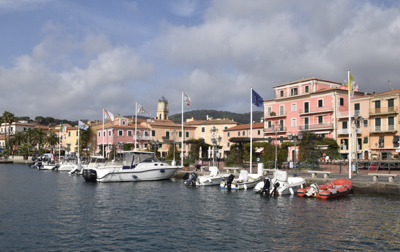
After lunch on our ship, we went out to explore Portoferraio on our own. It’s the largest city on the island of Elba and it was well fortified historically with three separate 16th century fortresses.

Impressive sailboats lined the U-shaped harbor but most of the shops and restaurants were closed. We guessed that it was an active port during warmer seasons.

Sunday October 23: During the night, the Onward moved westward and docked at the large commercial port of Olbia, Sardinia, Italy. I looked out to see inter-island ferries offloading trucks and cars. We had a leisurely breakfast at the Windows Cafe and prepared to go exploring.

There were no signs of a shuttle bus or directions to one at the disembarkation door so we went through a gate on the main thoroughfare across from the commercial port. A guard who was standing there pointed toward town. We walked for about 20 minutes until we reached the old town of Olbia.

We passed the Archeology Museum which looked interesting, but it was closed today. We found Corso Umberto I, which was the main pedestrian street in the historic center of Olbia. The street was lined with tourist shops and restaurants but there were few people since it was Sunday morning.

Following a sign, we turned into a small side street to see the church of San Paolo. The building was built on the ruins of a pagan temple from the Roman era and the church dates from the 15th century. The tiny church is noteworthy for its colorful majolica dome which was constructed in 1939.

We walked several blocks up to a main cross street and decided to sit at one of the local restaurants and have a snack. Since it was lunch time, the restaurants was crowded with locals and tourists.
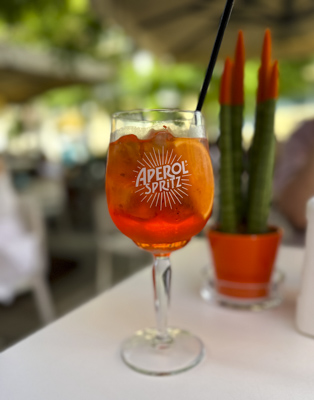
Eventually, we went back to the ship to relax and catch up on our journals. Some of the large Mediterranean ferries were painted with cartoon characters.


Monday October 24: Porto Vecchio, Corsica, France: The island of Corsica is only eight miles north of Sardinia and a 50-minute ferry carries passengers between the islands. The fact that Corsica is a French island and Sardinia is part of Italy, reflects the long history of conflicts among the Mediterranean countries.

The ship docked near the town of Porto Vecchio early in the morning. It was another beautiful sunny day. We quickly learned that the town was built in two parts on a steep hill and it was a strenuous walk to get to the upper area. Fortunately for us, the French government provides free shuttle-bus service.

Restaurants lined the small harbor but didn’t have many customers. The jitney bus was full of local people, not tourists. We had the feeling that the summer season was over in Porto Vecchio. The bus left us off at the old town center which had a kiddie merry-go-round in the middle.

The Citadel of Porto Vecchio was built in 1539 by the rulers of Genoa. It was destroyed and rebuilt three times from 1540 to 1589. The Republic of Genoa finally gave the island to France in 1768. We paid a small admission fee to climb the stone stairs to see wonderful views from the top of the fortress.


We sat in the little square to have soft-drinks and people-watch. Later, rather than wait for the jitney, we walked down the hill and back to the ship. The weather was warm and sunny – a real delight for this time of year. We returned in time for a late lunch onboard and relaxed for our next port-of-call.

Tuesday October 25: Mahon, Menorca, Spain: The distance is 288 miles across the Mediterranean Sea from Porto Vecchio, Corsica to the island of Menorca. This is one of the Balearic Islands which are part of Spain. The Azamara Onward crossed at night and was due to arrive at the port city of Mahon at one o’clock in the afternoon. We went out on deck to watch the ship cruise into the beautiful harbor.

Mahon (or officially Mao in the Catalan language) has one of the longest natural harbors in the world. It was a gorgeous three mile journey from the mouth of the harbor to the dock. We enjoyed a ship-board bar-b-que lunch outdoors on the pool deck before going ashore.

The historic center of the capital city was built on top of high cliffs. Fortunately, there are steps and an elevator up to the top. We arrived just outside the Carmelite Cloister which has been converted to a covered market selling everything from local produce to shoes, jewelry, clothes, and speciality food.
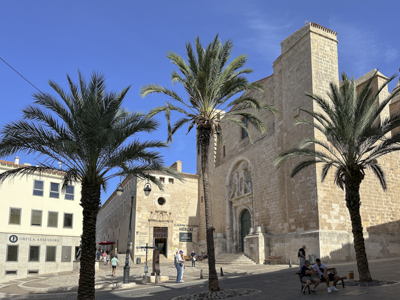
The outdoor courtyard of the cloister is also used as a performance space. An escalator leads down to a large supermarket built under the cloister. It was an amazing use of space. Near the cloister, in the Prince’s Plaza, is the famous Fish Market known for its fresh fish and prepared tapas and other goodies.

As we walked around the plazas and streets, we were surprised that many shops seemed to be closed and there were very few tourists. At first we thought is was a local holiday or “siesta” time, but realized that tourist season was over. Menorica, like the other islands on this trip, were closing for the winter.

The central part of Mahon was fashionable and clean with many interesting shops housed in pastel stone buildings. There were small plazas with charming outdoor cafes at the ends of every street. We enjoyed walking around the town and eventually returned to the ship.

Tonight was Azamara’s White Night Party. The pool deck was transformed to an elegant outdoor bar-b-que with white tablecloths and candles. It was a fun evening and the weather was perfect.

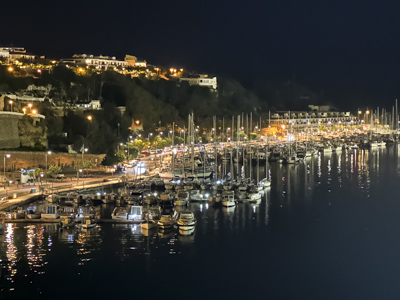
Wednesday October 26 Palma, Mallorca, Spain: I was so excited to finally get to Mallorca that I awoke early, just as the Onward approached the harbor of Palma. We had breakfast outdoors on the aft deck as the ship docked. The weather has been unseasonably warm – up to the mid 70s – but good for us.

Palma is a large city of over 400,000 people and the capital of the Balearic Island of Mallorca. It has been an international resort city and holiday island for decades. We had a 10 minute bus ride from where the ship was docked to the city center. The massive 13th century Santa Maria Cathedral (locally referred to as La Seu) overlooks the Bay of Palma.

The Gothic cathedral was built on the site of a Moorish mosque beginning in 1229. The adjacent Royal Palace of La Almudaina was originally an alcazar or Islamic castle built during the time of Muslim rule in Spain between 902 and 1229. Almudaina has been modified over the centuries and today is a museum and also serves as the official summer residence of the King of Spain and members of the royal family.

We waited in line to see the interior of the cathedral. Sunlight poured in through the stained glass windows and cast rainbow hues of light on the tall Gothic columns. It was very impressive!

We explored the narrow streets of the old town with thousands of other tourists. We walked up to the Placa Magor (the Spanish version of Piazza Maggiore in Italy) and found a small tapas bar for lunch. What fun! I have to return to Mallorca soon to see more!


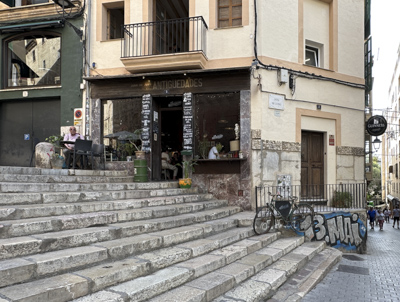
Thursday October 27: Valencia, Spain: Another day and another wonderful city. This time it’s Valencia Spain. After the ship docked in the busy harbor, we took a shuttle to the center of the city and entered the “old town” through the Torres de Serranos. The tower was a defensive structure built in 1392 and was part of the original medieval wall surrounding Valencia. Fortunately, it was saved from demolition when the city walls were knocked down in 1865.

We crossed a bridge over the Turia Gardens and looked down at the lovely green space. The city government diverted the River Turia, which frequently flooded, and created a beautiful urban garden. The seven mile park has a zoo, an arts & science museum, sports fields and facilities, foot paths, performance venues, as well as riverbed gardens. It is a real asset to the people of Valencia.

We had read about the famous market in Valencia, so we walked through the old town to the Mercado Central. The building was completed in 1928 and decorated in Valencian Art Nouveau style. The Central Market is one of the largest public markets in Europe.
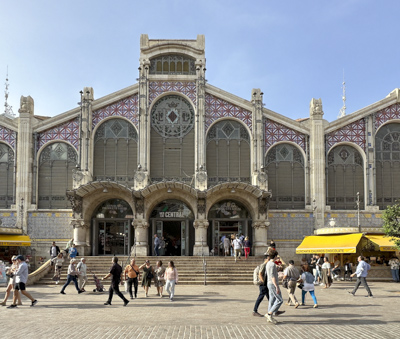

We decided Valencia was another wonderful city to explore but we didn’t have enough time to see and experience everything we wanted on this trip. Valencia was added to our “must return to” list.

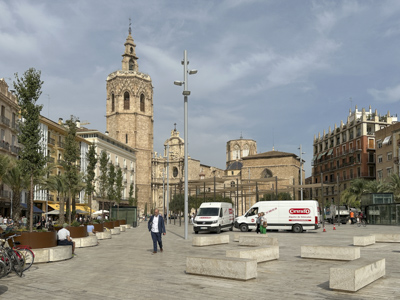
Friday October 28 Barcelona Spain: We’re almost at the end of the 7-Day “intensive” cruise. The Azamara Onward arrived in the huge international port of Barcelona before dawn. The cruise company gave everyone an extra night aboard the ship, so we could explore the city during the day, spend the night in our cabin, and disembark Saturday morning. We had already made plans to stay in Barcelona until Monday November 7th.

Barcelona is one of our favorite cities, so it was wonderful and exciting to be there again! We know our way around; we have favorite places to visit; food and restaurants to try again; new sights to see. On our first day in Barcelona, we walked up La Rambla, the main pedestrian street that runs from the port up to the always busy Placa de Catalunya.
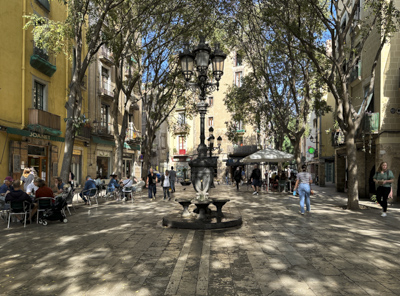
Saturday October 29: Barcelona Spain: We disembarked from the Azamara Onward and checked into the Hotel 1898 located on La Rambla. We stayed there before and like the location because we can walk or take the Metro to anything in the city. It’s also a quiet comfortable hotel with a roof-top sitting area. We had nine days in Barcelona so I took a zillion photos. Below are highlights of this wonderful city.

We discovered the former Hospital de Sant Pau which is a UNESCO World Heritage Site. The complex was built between 1901 and 1930 and is composed of 12 pavilions connected by underground tunnels. It was designed by a well-known Catalan architect and functioned as a hospital until 2009. After extensive restoration, today it is a museum and cultural center.

We walked past Antoni Gaudi’s cathedral, the Sagrada Familia, to see the progress of its construction. It is supposed to be finished in 2026 to celebrate the 100th anniversary of the famous architect. We revisited a few other Gaudi designed buildings on this trip. They are amazing structures!

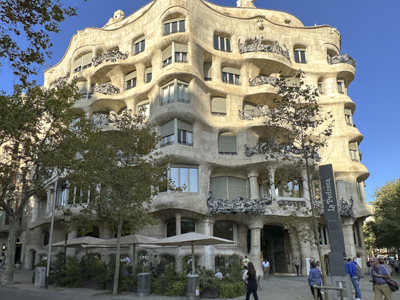
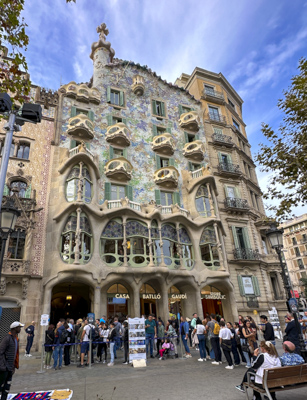
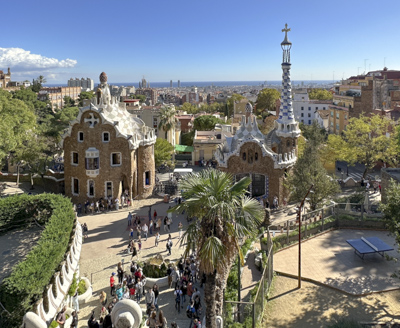
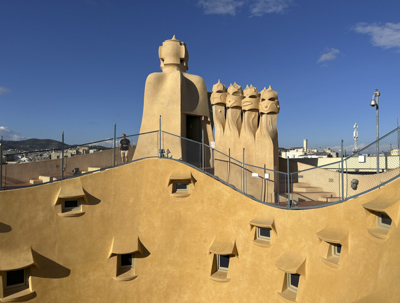
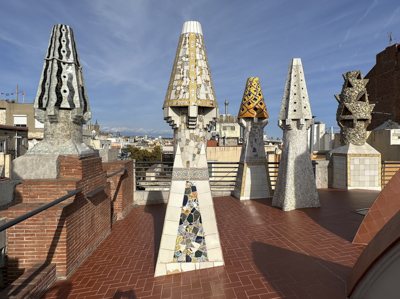
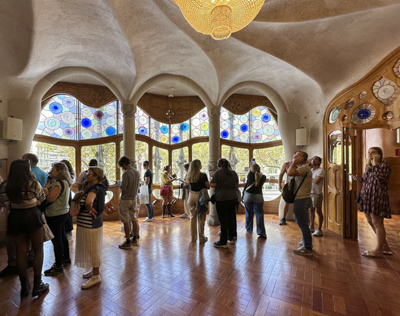
One day, we took a train out of the city to visit the Benedictine Abbey, Santa Maria de Montserrat. After an hour train ride, we took a Rack Railway up to the abbey. The Monastery of Montserrat was founded in the 11th century and rebuilt between the 19th to 20th centuries. It was a very interesting day-trip.

Barcelona is full of good restaurants serving tapas, paella, and pintxos – Basque or Catalan finger foods.
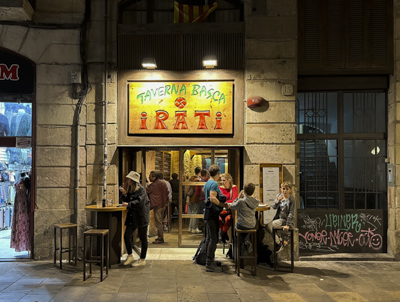


One day we took a taxi up Montjuic hill to visit the National Museum of Art of Catalonia. The impressive building was built in 1929 and houses a wonderful collection of ancient Romanesque and modern art representing the Catalan region. Behind the building was a large arena or performance space.
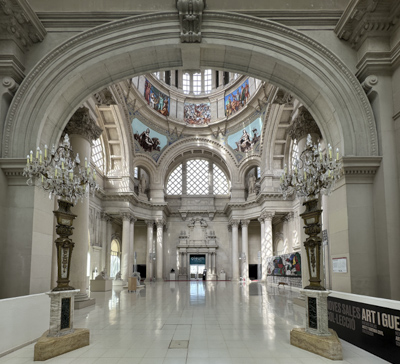
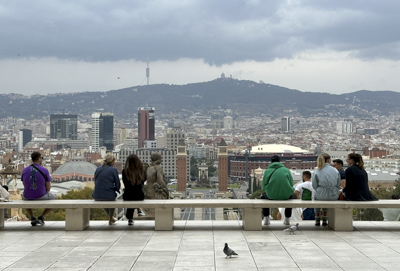
Jeff discovered that visitors can take an elevator to the top of the Christopher Columbus monument located near the harbor. There is a small entrance fee to ride in the tiny 3/4 person elevator.

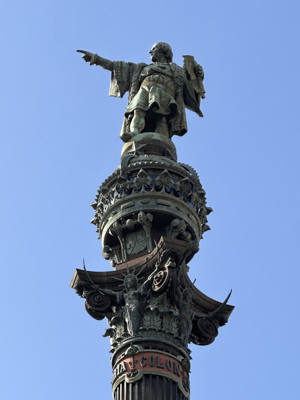



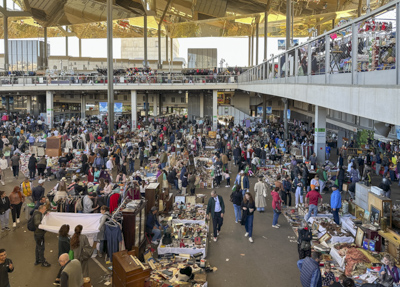
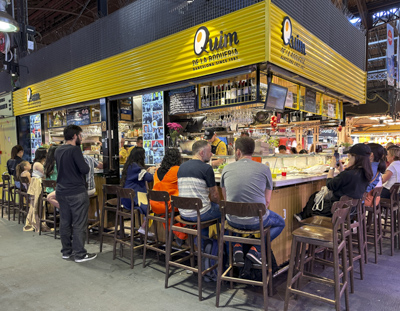

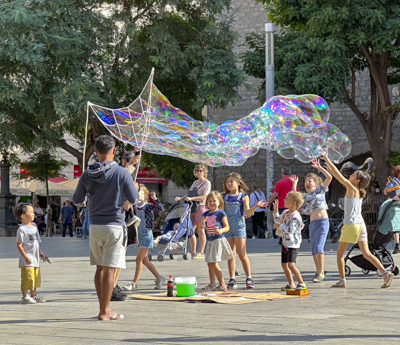
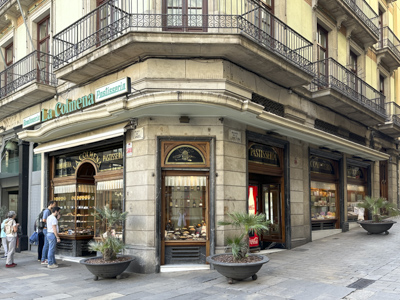
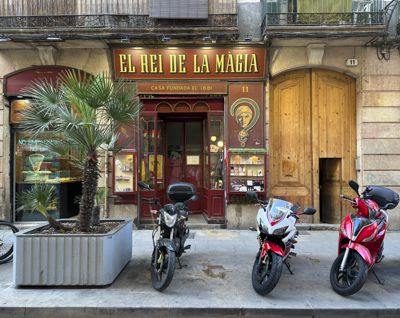

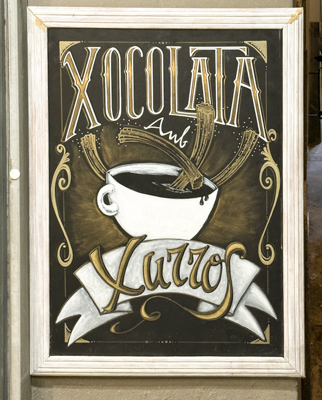
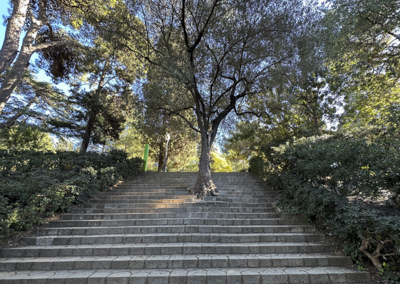
Monday November 7 Barcelona to New York: We flew home after staying in Barcelona for 9 days. I encourage everyone to go to Barcelona as soon as you can and stay as long as possible. It is a wonderful fun city; full of things to do and see; great food; friendly people. We had a fantastic time! We discovered new places to see and experience and we revisited sites we saw on a previous trip. Antoni Gaudi’s creations are thrilling to see every time. Barcelona is an easy city to walk around and the public transportation system-Metro and buses-are modern and efficient. BRAVA BARCELONA!!